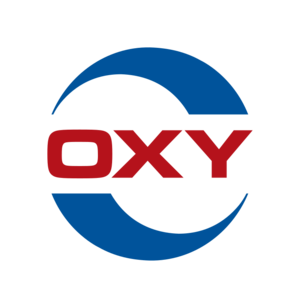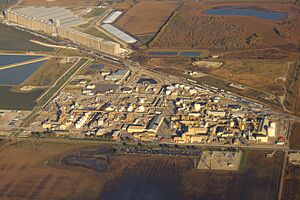Occidental Petroleum facts for kids
 |
|
| Public company | |
| Traded as | |
| Industry | Energy industry |
| Founded | 1920 |
| Headquarters | Houston, Texas, U.S. |
|
Key people
|
|
| Products | Chemical substances |
|
Production output
|
3,512 thousand barrels of oil equivalent (21,490,000 GJ) per day (2021) |
| Revenue | |
|
Operating income
|
|
| Total assets | |
| Total equity | |
|
Number of employees
|
|
Occidental Petroleum Corporation, often called Oxy, is an American energy company. It explores for oil and natural gas in the United States and the Middle East. Oxy also makes chemicals in the United States, Canada, and Chile. The company's main office is in Houston, Texas.
History of Occidental Petroleum
Occidental Petroleum started in Los Angeles, California, in 1920. In 1957, Armand Hammer became the company's leader. He helped Oxy grow a lot.
Early Growth and New Discoveries
In the 1960s, Occidental expanded its work to many countries. These included Peru, Venezuela, and the United Kingdom. In 1961, the company found the Lathrop Gas Field in California.
In 1965, Oxy began exploring for oil in Libya. They worked there until 1986. In 1968, the company started making chemicals. They bought Hooker Chemical Company.
In 1971, Oxy planned to build an oil refinery in England. But construction stopped in 1975 because of an energy crisis. The site was never finished.
International Deals and Challenges
In 1973, Occidental made a big deal with the Soviet Union. They traded phosphate for natural gas. This deal was worth a lot of money.
Also in 1973, Libya took control of some of Oxy's assets there. In 1974, Oxy signed a new oil exploration deal with Libya. But in 1986, the company stopped working in Libya again. This was due to rules from the United States. Oxy returned to Libya in 2005.
Occidental was one of the first companies to study oil shale. This is a type of rock that contains oil.
In 1983, Oxy and Ecopetrol found a huge oilfield in Colombia. It was called the Caño Limón oilfield. In 1997, Oxy bought the Elk Hills Oil Field for $3.65 billion.
In 1986, Oxy started a joint company with Church & Dwight. They made a chemical plant in Alabama.
On July 6, 1988, a terrible accident happened. An explosion on Oxy's Piper Alpha oil platform in the North Sea caused a fire. Sadly, 167 people died. This was a very serious offshore disaster.
Leadership Changes and Sales
Armand Hammer passed away in 1990. Ray R. Irani then became the new chairman and CEO. In the early 1990s, Occidental sold off some of its businesses. This included its coal operations.
In 2006, the government of Ecuador took over Oxy's oil interests in the Amazon Rainforest. In 2016, Ecuador agreed to pay Oxy $980 million. This was to make up for the earlier takeover.
In 2011, Stephen I. Chazen became the new CEO. In 2013, shareholders voted to remove Irani as chairman. During Irani's time, the company grew a lot. It became more focused on oil and gas.
Recent Developments and Focus Areas
In 2010, Oxy bought oil properties in North Dakota. These were later sold in 2015. The company also sold its oil reserves in Argentina. It then bought new properties in Texas and North Dakota.
In 2011, Oxy partnered with Abu Dhabi's state oil company. They worked together to develop the Shah Field. This is one of the largest natural gas fields in the Middle East.
In September 2014, Occidental moved its main office to Houston, Texas. The company also sold parts of its pipeline business. In 2014 and 2016, Oxy gave shares of California Resources Corporation to its own shareholders.
In 2015, Oxy started a carbon dioxide flooding project in New Mexico. This helps get more oil out of the ground. In 2017, Oxy and Mexichem started a new chemical plant in Texas.
In May 2016, Vicki Hollub became the CEO of Occidental. She was the first woman to lead a major U.S. oil and gas company.
In 2018, Occidental was found partly responsible for the Bayou Corne sinkhole. This was along with other companies.
In 2020, Oxy sold its operations in Colombia to the Carlyle Group. But Oxy still has offshore exploration plans in Colombia with Ecopetrol.
Company Acquisitions
Occidental has bought several companies over the years.
- In 1981, Oxy bought IBP, Inc., a large producer of beef and pork.
- In 1988, the company acquired Cain Chemical.
- In 2005, Oxy bought Vintage Petroleum.
- In 2008, it bought a share in Plains All American Pipeline.
- In 2009, Occidental acquired Citigroup's Phibro energy-trading business.
- In August 2019, Oxy acquired Anadarko Petroleum for $57 billion. This was one of the biggest oil and gas deals ever.
- In August 2023, Occidental bought Carbon Engineering. This company develops technology to remove carbon dioxide from the air.
- In December 2023, Oxy acquired CrownRock, an oil producer in the Permian Basin. This deal was completed in August 2024.
How Occidental Petroleum Operates
Occidental Petroleum has three main areas of operation: oil and gas, chemicals, and decarbonization projects.
Oil and Gas Production
Oxy's oil and gas operations are mainly in the United States and the Middle East. They also have some projects in South America. As of December 31, 2020, Oxy had about 2.9 billion barrels of oil equivalent in its proven reserves. This means they know this amount of oil and gas is there. In 2020, the company produced about 1.35 million barrels of oil equivalent per day.
United States Operations
In 2020, Oxy's U.S. operations produced about 1.037 million barrels of oil equivalent per day. This was 77% of the company's total production. A large part of this comes from the Permian Basin. Oxy is the biggest oil producer there.
The company uses different methods to get oil and gas. One method is called enhanced oil recovery. This is where carbon dioxide and water are pumped underground. This helps push out more oil and gas.
Middle East Operations
Oxy's oil and gas work in the Middle East is in Oman, Qatar, and the United Arab Emirates. This region produced about 251,000 barrels of oil equivalent per day in 2020. This was about 19% of Oxy's total production.
Oxy is the largest independent oil producer in Oman. In Qatar, it is the second-largest offshore oil producer. Oxy is also part of the Dolphin Gas Project. This project sends gas to Oman and the United Arab Emirates.
South America Operations
In Colombia, Oxy's subsidiary, Anadarko Colombia, is working with Ecopetrol. They are exploring for oil offshore in the Caribbean Sea. They plan to drill a very deep offshore oil well.
In Peru, Anadarko Peru, another Oxy company, has completed a project to map the ocean floor. This helps them find oil and gas.
Chemical Manufacturing
OxyChem is a company fully owned by Occidental. It makes important chemicals like polyvinyl chloride (PVC) resins, chlorine, and sodium hydroxide. These chemicals are used to make plastics, medicines, and water treatment products.
OxyChem also makes other chemicals. These include caustic potash and calcium chloride. OxyChem has factories in the United States, Canada, and Chile. It also owns Armand Products Company with Church & Dwight. This company sells potassium carbonate.
Decarbonization Projects
Occidental Petroleum is working on projects to help the environment. In June 2024, Oxy signed an agreement with TAE Technologies. They are looking into using nuclear fusion technology. This technology could provide clean energy for Oxy's direct air capture (DAC) projects.
DAC is a process that removes carbon dioxide (CO2) directly from the air. It uses a lot of energy. The partnership aims to power these DAC projects with clean energy. TAE Technologies is working on advanced nuclear fusion. They plan to have a demonstration project by 2025. A commercial facility could be ready in the 2030s.
See also
- List of oil exploration and production companies
Books
- Epstein, Edward Jay. Dossier: The Secret History of Armand Hammer. New York: Random House (1996). ISBN: 978-0679448020. 418 pages.


